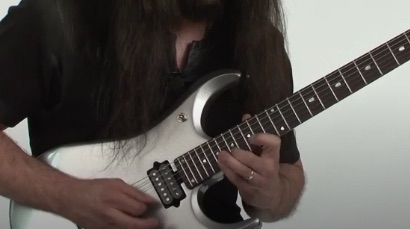Romancing the Fretboard: Chopin Arranged for Guitar, Part 3
Try to nail John Petrucci's six-string arrangement of Chopin's Piano Concerto in A minor, Opus No. 2.

Well, gang, here it is: the final installment of Chopin's Piano Concerto in A minor, Opus No. 2. Those of you who have braved the storm of 16th notes over the past two columns have earned the right to pat yourselves on the back.
You're going to get a bit of a reprieve this time, because, at the beginning of this section, Chopin restates the first six bars of the piece and then adds bars 15-17 of the opening section for good measure (use my column Romancing the Fretboard, Part 1 as a reference). Assuming you've worked out these parts already (and I hope you did), that only leaves you with five new measures to learn.
Compared to the amount of information you tackled the last couple of months, this lesson should be a piece of cake! Notice that there are a number of quick position shifts, particularly on the same string, in measures 7 and 8 and 10-13. Executing them properly is not as hard as it looks.
The trick is to move your entire left hand in one quick motion to the next position instead of stretching into it with your pinkie or index finger. Start slowly at first, and make sure you refer to the tablature for the proper fingerings.
There's only one other tricky spot in this section. In measure 9, you'll come across a fairly difficult passage that requires some serious left-hand stretching. Here, Chopin leaves the chromatic scale for just a brief moment to outline the Dm, Am and E7 chords using thirds and fourths as they occur in the A harmonic-minor scale.
Notice that the first note of each interval is approached chromatically from below. Use only your index finger and pinkie to play the intervals; it will make executing the wide stretches easier. Again, take it slowly and don't force anything-you don't want to hurt yourself! I use the unorthodox left-hand fingering in measure 9 because it enables me to maintain a smooth alternate picking pattern.
This piece is played at an extremely fast tempo, and the last thing you want to do is break your right-hand rhythm worrying if the next note lands on an upstroke or downstroke. Keep in mind that you can "borrow" melodic ideas from this piece and incorporate them into your own solos. For example, the second measure can be used as a great connecting line from one A minor-pentatonic or blues lick to another. Experiment using other lines from this piece.







Once you have this section down, try playing the concerto in its entirety. Record yourself playing the chord changes at a slow tempo (or have a friend play them) and go for it! There's nothing like tackling a challenging piece of music to make you a better player.
If you liked working on this piece and want to check out more of Chopin's music, pick up a copy of Chopin: Complete Preludes and Etudes for Solo Piano, published by Dover Books. Other classical composers whose work sounds great arranged for guitar include the "three B's": Bach, Beethoven and Brahms. and remember: always, always approach music with an open mind. Listen to other musical styles and learn from them. It will help your development as a musician immeasurably.
This column originally appeared in Guitar World as part of John Petrucci's "Wild Stringdom" column.
Get The Pick Newsletter
All the latest guitar news, interviews, lessons, reviews, deals and more, direct to your inbox!









